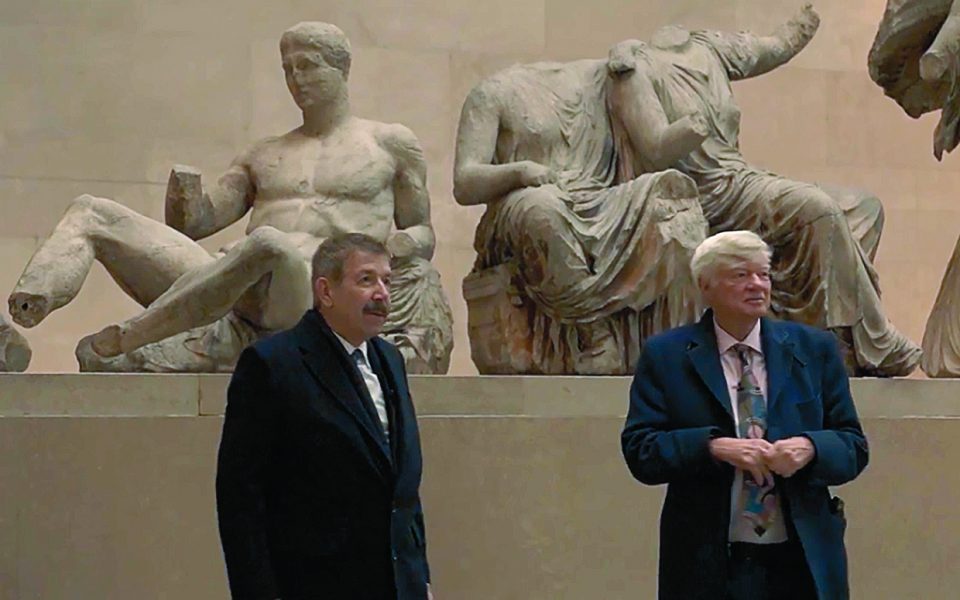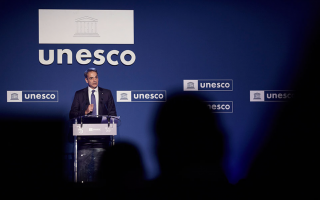Expatriate protector of the Parthenon Marbles
Industrialist John Lefas explains to Kathimerini how the issue came to his attention and spurred him to finance a campaign to reclaim them

John Lefas was in the Middle East for work last week, but his mind was in London and on what was being done about the Parthenon Sculptures in the wake of Greek Prime Minister Kyriakos Mitsotakis’ meeting with his British counterpart, Boris Johnson.
An industrialist with plastics and chemicals plants by profession, he has been working actively but quietly for the sculptures’ return for the past two years. How did this involvement come about? “Mainly from my love for Greece, for art and from the fact that I cannot abide injustice. And the situation with the sculptures is a grave injustice. A lot of lies have been told,” he says.
Our interview, the first he has granted on the issue, was conducted in Greek and he struggled every so often to find the right words. “I am sorry. It’s just such a sensitive subject, but I’ve also been abroad for many years,” he says.
Lefas was born in Thessaloniki, northern Greece, and was a student at Athens Polytechnic during the 1973 anti-dictatorship uprising. He graduated in 1975 and went on to complete his postgraduate studies in Toronto. He married a Greek woman there and they went into business together, before moving to the United States and later to the United Kingdom.
It was in London about three years ago when an item in the news grabbed his attention. It was on the SYRIZA government’s decision not to use the work done by Geoffrey Robertson, Norman Palmer and Amal Clooney, the three lawyers who, under the previous Greek government, led by Antonis Samaras, had studied the issue of the return of the sculptures and written a legal proposal of how this could be carried out. He found a summary of the proposal online later that same night. He read it and before going to bed sent an email to one of the three lawyers, Robertson, asking if he could, as a Greek citizen, take legal action for the marbles’ return. He was surprised at how quickly the lawyer got back to him. “He wrote very politely that it was probably a bad idea, but agreed to meet to discuss it,” says Lefas.
They met for the first time at the British Museum in London. They had tea and walked to the Parthenon Gallery. “Even though I’d seen it so many times, I felt that same tightening in my chest walking into that room – that box without windows. It’s like they have them buried in a tomb,” he comments.
The two men met at the same place again later. That’s where Lefas told Robertson that he wanted to make sure all the work the team of lawyers had done would not go to waste. The idea was for Robertson to write a book that would be funded by Lefas. “Who Owns History? Elgin’s Loot and the Case for Returning Plundered Treasure” came out in late 2019 and Lefas and his team got to work.
“We sent 5,000 copies to universities, members of the Anglican Church, British MPs and Euro MPs in the hope that the issue would be put on the agenda in light of the Brexit agreement,” he explains.
A copy of the book also made it to the office of the Greek prime minister, with a dedication by Robertson saying he hoped that the marbles will be returned during his tenure. A few months later, Prime Minister Kyriakos Mitsotakis’ wife Mareva Grabowski-Mitsotakis told the Financial Times that it was the best book she had read recently. “It’s a very persuasive moral and legal argument as to why the Parthenon Marbles belong to Greece and should be permanently returned to the new Acropolis Museum,” she said.
Next steps
One of the initial aims was to get the issue back onto the agenda in Parliament in the UK. They believed this could be achieved via Scottish MP Margaret Ferrier. Luck was not on their side. Even though Ferrier was ready to put the question to the House, she tested positive for Covid-19. She took the train back to Scotland and had to resign after she was found to have been traveling while knowing she was infected. Lefas’ team had lost an ally but was not ready to throw in the towel. They put together another ambitious scheme: an event at the Acropolis Museum to launch the book. The presenters would be Robertson and the popular and respected British actor and writer Stephen Fry. The guest list would include British lawmakers mainly, but also people who could influence public opinion in favor of the sculptures’ return, such as Amal Clooney and her husband George.
Lefas traveled to Greece and presented his idea to the government, saying he would cover all the costs. The event was initially scheduled for April and was then put off until October because of the pandemic. When everything was ready to go, the team was informed of Mitsotakis’ upcoming trip to London and his plan to put the issue directly to the British prime minister.
“We decided to have the event after it becomes clear what the government’s next moves will be. We have created a mechanism and we are ready to put it into operation whenever this is asked of us,” says Lefas.
‘Lies and half-truths’
Geoffrey Robertson admits that he was disappointed by Boris Johnson’s response to the Greek prime minister.
“He is claiming that this is a matter of the trustees, but that is a lie. British law does not allow the trustees to part with the marbles. There is a specific law which prevents the trustees of the British Museum from giving away or giving back or restituting any items that have been deposited in their collection. Their hands are tied by the law. It is a matter for Parliament – i.e. the government – to free them by changing the 1963 law. I’m afraid that this is another British devious and dishonest response. They first claimed that Elgin obtained the marbles lawfully, which obviously he didn’t,” he tells Kathimerini.
In his book, the Australian lawyer refers to specific documents that discredit the claims made by Elgin and the British Museum, and he accuses the latter of telling “a string of carefully constructed lies and half-truths.”
He insists that legal recourse to the International Court of Justice at The Hague is the only way to shake them and get them to return the sculptures, which, in the meantime, have been out of sight for months after the gallery was closed due to water damage.
“I hate to think what’s happening to the marbles at the moment, and the public can’t see them for a whole year,” says Robertson.





